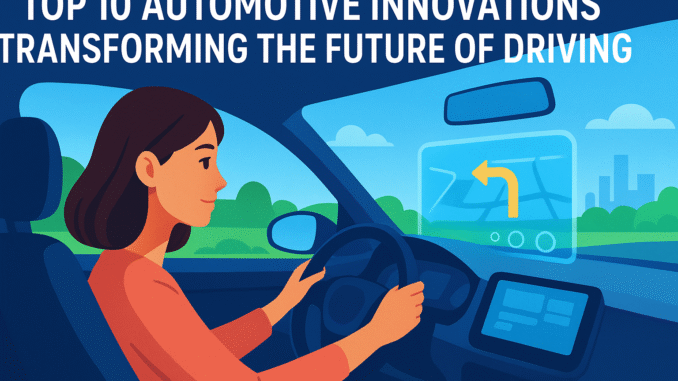
Top 10 Automotive Innovations Transforming the Future of Driving
The automotive industry is experiencing one of the most significant transformations in history. From the introduction of electric vehicles (EVs) to advanced driver-assistance systems, technology is reshaping the way people drive, maintain, and interact with their cars. These innovations are not just about comfort and style—they are redefining safety, sustainability, and mobility.
In this article, we will explore the top 10 automotive innovations that are paving the way for the future of driving and what they mean for drivers, manufacturers, and the environment.
1. Electric Vehicles (EVs) and Sustainable Mobility
One of the most impactful innovations in the automotive sector is the rise of electric vehicles (EVs). Unlike traditional vehicles powered by fossil fuels, EVs run on rechargeable batteries, significantly reducing greenhouse gas emissions.
- Why it matters: EVs are helping to create a cleaner and more sustainable future by cutting dependence on gasoline.
- Global adoption: Governments worldwide are offering incentives, tax benefits, and charging infrastructure to encourage EV use.
- Future outlook: As battery technology improves, EVs will offer longer ranges, faster charging times, and more affordable prices.
2. Autonomous Driving Technology
Self-driving cars are no longer a futuristic dream—they are becoming a reality. Autonomous driving systems use a combination of artificial intelligence (AI), sensors, and cameras to navigate roads without direct human control.
- Key features: Adaptive cruise control, lane-keeping assistance, and automated parking.
- Safety benefits: Reduces human errors, which cause the majority of road accidents.
- Industry leaders: Companies like Tesla, Waymo, and traditional automakers are racing to perfect this technology.
While fully autonomous cars are still under development, partial automation is already changing the driving experience.
3. Advanced Driver Assistance Systems (ADAS)
ADAS technology enhances driver safety and convenience by offering features like blind-spot monitoring, automatic emergency braking, and collision warnings.
- How it helps: ADAS reduces accident risks by alerting drivers of potential hazards.
- Accessibility: Many modern cars now include these systems as standard, not just luxury vehicles.
- Impact: These features make driving less stressful and much safer, particularly for new drivers.
4. Vehicle-to-Everything (V2X) Communication
Cars are becoming smarter, and V2X communication allows them to connect with each other and surrounding infrastructure.
- How it works: Vehicles can share information about traffic conditions, road hazards, or accidents in real time.
- Benefits: Improves road safety, reduces congestion, and enhances traffic flow.
- Example: A car could warn nearby vehicles if it suddenly brakes or encounters icy conditions ahead.
V2X is expected to play a huge role in creating smart cities where cars, roads, and traffic systems communicate seamlessly.
5. Artificial Intelligence and Machine Learning in Cars
AI is powering many aspects of modern vehicles. From predictive maintenance to personalized infotainment systems, AI-driven technology is transforming the driving experience.
- Practical uses: AI can detect potential mechanical issues before they cause breakdowns.
- Personalization: Cars can learn driver preferences for seat position, climate control, and music.
- Navigation: AI improves GPS systems by analyzing traffic in real time to suggest faster routes.
AI is essentially making vehicles more intelligent, efficient, and user-friendly.
6. Next-Generation Battery Technology
The performance of EVs largely depends on the quality of their batteries. Traditional lithium-ion batteries are evolving into solid-state batteries, which offer:
- Higher energy density: Longer driving ranges.
- Faster charging: Reduced wait times at charging stations.
- Improved safety: Less risk of overheating and fire.
As battery costs continue to fall, electric vehicles will become more affordable for the average consumer, further boosting adoption.
7. Augmented Reality (AR) Dashboards
Imagine driving with real-time navigation displayed directly on your windshield. AR dashboards use augmented reality to project vital information, such as speed, directions, and hazard warnings, onto the driver’s field of view.
- Advantages: Drivers keep their eyes on the road instead of glancing at screens.
- Examples: Some luxury automakers already integrate AR navigation and heads-up displays.
- Future potential: AR could soon include advanced features like detecting pedestrians or highlighting safe driving lanes.
This innovation bridges the gap between safety and convenience.
8. Connected Cars and the Internet of Things (IoT)
The concept of connected cars is revolutionizing automotive technology. Through IoT integration, cars can connect to smartphones, smart homes, and cloud services.
- Benefits: Remote diagnostics, over-the-air software updates, and predictive maintenance.
- Enhanced experience: Drivers can lock/unlock their car, start engines, or check fuel levels remotely using mobile apps.
- Safety: Real-time data exchange improves navigation, emergency response, and overall driving efficiency.
This trend is turning vehicles into smart devices on wheels.
9. Green and Lightweight Materials
Beyond fuel efficiency, automakers are focusing on eco-friendly materials to make cars lighter, stronger, and more sustainable.
- Examples: Aluminum, carbon fiber, and recycled plastics.
- Impact: Lightweight vehicles consume less energy and improve overall efficiency.
- Sustainability factor: Manufacturers are also experimenting with biodegradable materials for interiors.
The use of advanced materials not only improves performance but also supports global sustainability efforts.
10. Shared Mobility and Subscription Models
The future of driving is not just about owning cars—it’s about accessing mobility as a service.
- Shared mobility: Car-sharing and ride-hailing services reduce the need for private car ownership.
- Subscription models: Drivers can subscribe to cars like they subscribe to streaming services, allowing flexibility to switch vehicles based on needs.
- Environmental impact: Fewer cars on the road mean less congestion and lower emissions.
This innovation reflects changing consumer preferences and urban lifestyles.
Conclusion
The automotive industry is undergoing rapid transformation, driven by technology, sustainability, and consumer demand. From electric vehicles and AI-powered systems to shared mobility and AR dashboards, these innovations are not only reshaping the way people drive but also how they think about transportation.
As these advancements continue to evolve, the future of driving promises to be smarter, safer, greener, and more connected than ever before. For drivers, this means embracing change and preparing for a future where cars are not just vehicles but intelligent mobility solutions.